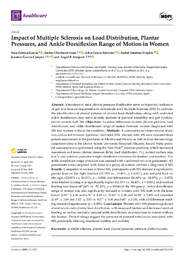Título :
Impact of Multiple Sclerosis on Load Distribution, Plantar Pressures, and Ankle Dorsiflexion Range of Motion in Women |
Autor :
Zúnica García, Sara 
Chicharro-Luna, Esther 
Gracia Sánchez, Alba 
Jiménez-Trujillo, Isabel 
Garcia-Campos, Jonatan 
Sempere, Ángel  |
Editor :
MDPI |
Departamento:
Departamentos de la UMH::Ciencias del Comportamiento y salud |
Fecha de publicación:
2025-05 |
URI :
https://hdl.handle.net/11000/37451 |
Resumen :
Alterations in static plantar pressure distribution serve as important indicators
of gait and balance impairments in individuals with Multiple Sclerosis (MS). In addition,
the identification of altered patterns of plantar load distribution, along with restricted
ankle dorsiflexion, may serve as early markers of postural instability and gait dysfunction
in women with MS. Objectives: To assess differences in static plantar pressure, load
distribution, and ankle dorsiflexion range of motion between women diagnosed with
MS and women without the condition. Methods: A cross-sectional observational study
was conducted between April and December 2024. Women with MS were recruited from
patient associations in the provinces of Alicante and Murcia, as well as from the neurology
outpatient clinic at the Doctor Balmis University Hospital (Alicante, Spain). Static postural
assessment was performed using the Neo-Plate® pressure platform, which measured
maximum and mean plantar pressure (kPa), load distribution (%), contact surface area
(cm2), and anterior–posterior weight distribution between the forefoot and rearfoot. The
ankle dorsiflexion range of motion was assessed with a universal two-arm goniometer. All
parameters were compared with those of a group of women without a diagnosis of MS.
Results: Compared to women without MS, participants with MS showed a significantly
greater load on the right forefoot (25.75% vs. 23.41%, p = 0.021), and reduced load on
the right (23.09% vs. 26.01%, p = 0.004) and left rearfoot (26.60% vs. 30.85%, p = 0.033).
Total forefoot loading was significantly higher (52.33% vs. 46.40%, p < 0.001), and rearfoot
loading was lower (47.64% vs. 52.42%, p = 0.006) in the MS group. Ankle dorsiflexion
range of motion was also significantly reduced in women with MS, both with the knee
flexed (5.95◦ ± 4.50 and 6.76◦ ± 4.69 vs. 15.45◦ ± 5.04 and 14.90◦ ± 5.43) and extended
(2.69◦ ± 3.69 and 3.12◦ ± 3.83 vs. 8.17◦ ± 3.41 and 8.60◦ ± 3.31), with all differences reaching
statistical significance (p < 0.001). Conclusions: Women with MS present significant
alterations in static plantar load distribution, with increased forefoot and decreased rearfoot
loading, as well as markedly reduced ankle dorsiflexion, in comparison to women without
the disease. These findings suggest the presence of postural imbalances associated with
MS, potentially affecting functional stability and mobility.
|
Palabras clave/Materias:
multiple sclerosis
plantar load
plantar pressure
pressure platform
static |
Área de conocimiento :
CDU: Ciencias aplicadas: Medicina |
Tipo de documento :
info:eu-repo/semantics/article |
Derechos de acceso:
info:eu-repo/semantics/openAccess
Attribution-NonCommercial-NoDerivatives 4.0 Internacional
Attribution-NonCommercial-NoDerivatives 4.0 Internacional |
DOI :
https://doi.org/10.3390/healthcare13111231 |
Publicado en:
Healthcare, 13(11), 1231 - May 2025 |
Aparece en las colecciones:
Artículos Ciencias del Comportamiento y Salud
|

 La licencia se describe como: Atribución-NonComercial-NoDerivada 4.0 Internacional.
La licencia se describe como: Atribución-NonComercial-NoDerivada 4.0 Internacional.
.png)